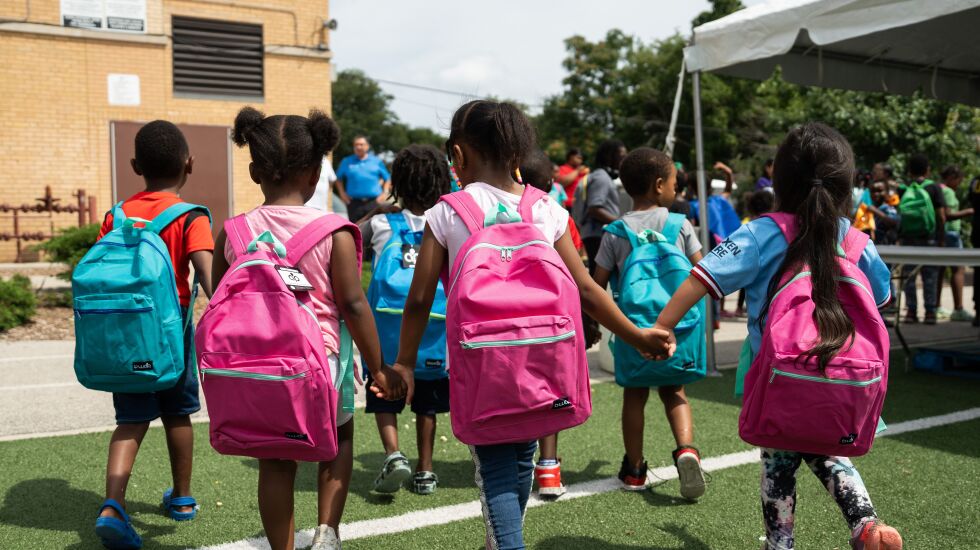
Chicago Public Schools students go back to the classroom on Monday, and as usual, CPS has any number of unanswered questions that show what’s at stake this school year.
What will happen to the thousands of students from magnet and selective schools who won’t have bus service to begin the year because of a crippling shortage of school bus drivers? Can schools successfully accommodate another expected influx of migrant students — beyond the 5,000 children from asylum-seeker families who enrolled at the end of last school year? How will the district fare under the new School Board and new mayor — who is a public school parent and a former teachers union organizer?
Beyond these latest questions, there’s the usual: How to fill teacher and staff vacancies, provide adequate services for the growing share of students with special needs — and most pressing, how to avert the fiscal cliff on the horizon once federal pandemic money runs out.
But there’s one area where CPS has begun to find answers: undoing the learning loss fueled by virtual learning during the pandemic by getting thousands of students into what experts call high-dosage tutoring.
If CPS can keep it up — and we strongly support the district’s goal of finding some means to expand and pay for HDT long-term, once pandemic money runs out — the impact on closing the achievement gap could be significant.
Providing adequate transportation, bilingual and special education services, social and emotional learning and other support are all important. But so, too, are programs that aim directly, and intensively, at what school is all about: learning.
“If we’re serious about addressing educational disparities, we need a way to help kids learn much more,” as Monica Bhatt, senior research director of the University of Chicago Education Lab, which is working with CPS on the tutoring initiative, puts it. “We know how to do it. We have the answer.”
How high-dosage tutoring works
High-dosage tutoring is defined as tutoring sessions of at least 30 minutes each that take place three times a week, during the school day, with trained tutors using a structured curriculum designed to meet students’ current level of learning. It’s critical that sessions be scheduled during the regular school day, not after school as so often happens with tutoring, Bhatt explains, for students to “get that consistency throughout the school year, so it’s not just a touchpoint.”
Federal pandemic funds have paid for high-dosage tutoring in school districts across the country, and Chicago, to its credit, has been a national model for its implementation, Bhatt and others tell us. For the new school year, data from CPS show 589 tutors have been hired so far, and 217 schools — out of more than 500 district-run schools — have signed up to participate. That, we hope, is just a head start: Last year, 671 tutors worked in 229 schools.
Consistent, long-term tutoring is what’s needed to help raise achievement in the underserved schools where children are most in need of academic support. Preliminary data show CPS students have begun to rebound from the decline in state test scores that occurred during the pandemic, but scores remain far too low, as an analysis by the nonprofit Chalkbeat found: Just 26% of CPS schoolchildren met or exceeded state standards for reading in the 2022-2023 school year, and only 17.5% met math standards.
Test scores are not the sole measure of learning, of course. And students who are traumatized by gun violence and poverty, as are so many Black and Latino children in CPS, need extra social and emotional support to succeed academically.
Even so, there’s no honest way to rationalize, year after year, the district’s lower-than-average scores on state and national achievement tests. If high-dosage tutoring can help reverse that long-standing trend, then go for it.
Research from the U of C Education Lab found that a previous model of high-dosage tutoring, provided in CPS from 2013-2015, had “immense impacts on student outcomes, with students gaining one to two-and-a-half years of additional math learning in just one year, compared to students who did not receive Saga tutoring.” That model provided 50-minute tutoring sessions to over 2,000 ninth- and 10th-grade students by the nonprofit Saga Education.
A CPS spokesperson said the district is “encouraged by the results we’ve seen through tutoring to date” and is evaluating options to sustain it long-term.
There are other ancillary benefits, such as easing the instructional burden on teachers and eventually, providing a pipeline of new teachers to the district. There is potential for civic involvement on this front, to help support an initiative with a track record.
CPS has more than enough problems and challenges. Fixing them, one step at a time, is essential if the district — and students — are to have a future.
The Sun-Times welcomes letters to the editor and op-eds. See our guidelines.







